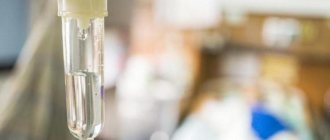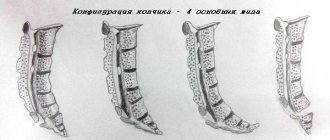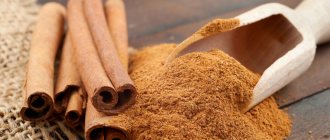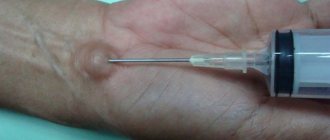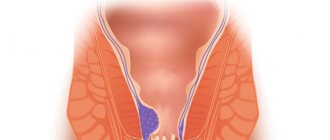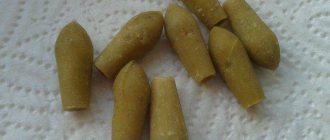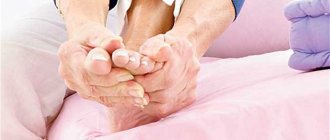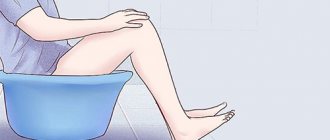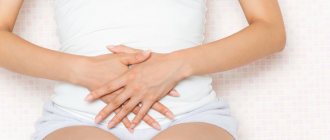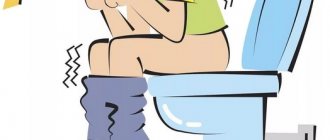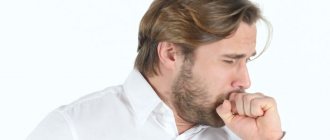Symptoms of the disease
Hemorrhoids in a child have the following symptoms:
- pain in the anal area;
- prolapse of hemorrhoids;
- anal itching after defecation;
- feeling of incomplete bowel movement;
- intestinal bleeding.
It is quite difficult to recognize hemorrhoids in newborns, because they do not sit on hard surfaces. This means that parents will not be able to see the characteristic behavior. The problem is detected only at the stage of inflammation of the vessels of the rectum. It is necessary to show the baby to the doctor in case of frequent constipation and constant crying.
It is possible to detect hemorrhoids in a child only at the stage of inflammation of the vessels of the rectum.
In a child aged 1-3 years
After completing 2 years of life, children may already complain of discomfort. The likelihood of hemorrhoids at this age is lower than in a one-year-old child, which is explained by the intestines’ adaptation to adult food. Two-year-old children prefer outdoor games, so blood stagnation does not occur.
If a child moves little due to a serious illness, the likelihood of developing hemorrhoids is high.
In this case, there is restless behavior, frequent crying, and fear of going to the toilet.
In children 4-5 years old
The following signs help recognize the disease at this age:
- irritability;
- discomfort when sitting on a hard surface;
- scratching in the anal area.
It is difficult to detect traces of blood in stool, because after the completion of the 3rd year of life, children begin to go to the toilet on their own.
A 5-year-old child suffering from hemorrhoids becomes very irritable.
For children 6-12 years old
The likelihood of developing hemorrhoids after 5 years increases sharply, because lifestyle changes after going to school. The child is forced to sit on an uncomfortable chair for several hours and eat irregularly. The ease of diagnosis at this age is explained by the lack of fear of treatment. An older child will not hide the presence of pain and burning in the anal area.
How do hemorrhoids develop in babies?
Hemorrhoids in a newborn - and this happens. In children under two years of age, hemorrhoids are rarely diagnosed, but unfortunately, it is impossible to call such a phenomenon an isolated case. True, the disease proceeds a little differently, and is caused by other reasons.
Hemorrhoids - symptoms in children:
- The child complains of itching and burning in the anal area;
- He says or shows that he has something in his butt (he thinks so);
- The child suffers from frequent constipation;
- There are drops or smears of blood in the stool, on panties, on toilet paper;
- Symptoms may be accompanied by an infectious syndrome with an increase in temperature to 38 degrees.
Parents themselves have difficulty identifying illness in their children: children are not able to explain what worries them. They hold their hand in the butt area, are afraid to go to the potty (or vice versa, sit on it for a long time), cry, are capricious, and do not allow adults to see what is happening.
These symptoms are a reason to take your child to the pediatrician. The pediatrician will identify the problem and tell you whether you need to see a specialist for treatment.
Hemorrhoids after childbirth photo
Hemorrhoids after childbirth cause great discomfort (photo 4). If you start it during this period, it will develop into chronic. Symptoms of the disease in women at this time are caused by the enormous load during pushing. During this period, hemorrhoidal cones can easily fall out. There is a fact that during difficult childbirth, hemorrhoids in children can be triggered by strong pressure of the birth canal. Postpartum female hemorrhoids (photo below) require special hygiene.
The first signs of hemorrhoids in women
In each case, the first signs of hemorrhoids in women (see photo 5) are individual. Often they are not paid attention to, and the initial stage of hemorrhoids, with timely treatment, is completely curable. Signs in women are expressed with a burning sensation, tingling, itching of the anus. Inflammation and swelling often occur, which are often expressed by heaviness in the intestines, increasing towards the anus. Traces of blood noticed on linen or toilet paper should also alert you. In women, stage 1 may only be manifested by mucus secretion.
Symptoms of hemorrhoids in women
Pain that occurs during bowel movements, the presence of blood, sometimes copious amounts - all these are symptoms of hemorrhoids in women (see photo 6). At the very beginning, discomfort is caused by an unpleasant feeling of a foreign body in the intestine. It is he who is a frequent harbinger of the disease. Frequent trauma to intestinal tissue can cause the development of tumors. Signs such as itching and burning are often wave-like, causing a lot of inconvenience.
What does external hemorrhoids look like in women?
External hemorrhoids in women (see photo 7) are characterized by protrusion of nodes or their loss, which causes additional stretching of the skin. Cones can be of different sizes. The appearance of hemorrhoids greatly complicates the process of sitting. The fallen tissues become swollen, their color depends on the stage of the disease. There is no difference in the symptoms of hemorrhoids in women and in men. Having external hemorrhoids increases the risk of contracting infections.
What internal hemorrhoids look like in women
Internal hemorrhoids in women (see photo are most common and have quite clear symptoms. It is not possible to see what hemorrhoids look like due to the location of the nodes in the middle of the rectum. Increasing with swelling, the nodes cause unpleasant heaviness and tingling. Internal hemorrhoids due to the pressure of the lumps causes microcracks into which moisture, sweat get in and cause pain, pinching. Sometimes internal bleeding occurs. The internal type is much easier to cure than other types of hemorrhoids. Read more in the article what are hemorrhoids on our website.
are most common and have quite clear symptoms. It is not possible to see what hemorrhoids look like due to the location of the nodes in the middle of the rectum. Increasing with swelling, the nodes cause unpleasant heaviness and tingling. Internal hemorrhoids due to the pressure of the lumps causes microcracks into which moisture, sweat get in and cause pain, pinching. Sometimes internal bleeding occurs. The internal type is much easier to cure than other types of hemorrhoids. Read more in the article what are hemorrhoids on our website.
Symptoms
Hemorrhoids in young children 4-5 months old at the beginning of development may not be expressed in any way externally. Protrusion of nodules may only rarely be observed at the time of crying or straining. And traces of blood may be visible on the diaper.
The main symptoms of hemorrhoids in children are as follows:
- First stage. In the first stages of development, babies suffer from burning and itching, which increase after bowel movements. Blood streaks are found in the stool.
- Stage II. The nodules noticeably expand in size, and pain appears during bowel movements. Inflamed fluid is released from the anus, leading to diaper rash in the folds. Hemorrhoidal bumps can come out of the anus and then come back.
- Stage III. The nodes protrude and come out both at the time of emptying and during movement. Intense pain appears, and it is difficult for the baby to sit.
- Stage IV. The knot comes out under different loads and cannot be set back. Possible complications: pinched node, necrotic, manifested inflammation.
If any of the above symptoms occur, you should immediately contact a proctologist for a full examination. Diagnostics includes stool and blood analysis, sigmoidoscopy, and palpation examination.
Treatment
Effective treatment of hemorrhoids will be achieved after properly selected medications.
At the beginning of its development, the pathology is amenable to therapeutic measures, but it is important to adhere to some rules:
- It will be difficult to cure hemorrhoids if the baby scratches the anus, spreading the infection;
- perform hygienic procedures, if a child has hemorrhoids, be sure to wash with warm water after bowel movements, use soft napkins instead of toilet paper;
- physical gymnastics has a beneficial effect on blood circulation;
- The child’s diet should be dominated by foods containing fiber (various cereals, fruits, vegetables), and drink at least 2 liters of liquid (compotes, water, juices) per day. Nutrition should be balanced and healthy.
Hemorrhoids in young children can be treated with folk remedies and topical medications. Surgical interventions are used very rarely, in severe cases.
Conservative methods
The doctor may prescribe the following:
- Rectal suppositories, ointments. Unfortunately, medications are not produced for small patients, so medications for adults are used, only they are divided into parts depending on body weight.
- There are certain drugs approved for ages 12-14.
- The child may be prescribed the following rectal suppositories: Gepatrombin, Relief, Ginkor Procto. Heparin, Procto-Glivenol, Relief are suitable as ointments. Proctosedyl ointment is approved for adolescents, but is strictly prohibited for infants.
- For 2-3 year old children, lighter suppositories with belladonna extract and sea buckthorn suppositories are used.
- Komarovsky advises using compresses with Vishnevsky ointment and calendula infusion for external therapy.
The medications described above have analgesic and anti-inflammatory effects. Effectively eliminate itching, burning, swelling in the anus. With the use of ointments and suppositories, healing of anal fissures is noted, stool is restored, and constipation is removed.
Traditional methods
Traditional methods of treatment are not contraindicated for manifestations of hemorrhoids:
- Sitz baths. For this purpose, medicinal plants are used: chamomile, oak bark. To prepare the infusion, you will need 1 tablespoon of the composition, add 200 ml of boiled water to it, infuse for 1 hour, filter. Pour into a container, the temperature should not exceed 38°C. Treatment lasts 5 days for 7-10 minutes.
- Microclysters. Conducted with rose hips or sea buckthorn. The main thing is that these products do not cause allergies in the child. 100 ml of oil is brought to 38°C, taken into a small enema, and inserted into the butt.
- Baby cream. Since hemorrhoids lead to dry skin, use a cream containing panthenol, mineral complexes, and cocoa butter.
- Chamomile steam baths. They help relieve signs of the disease. Pour a couple of tablespoons of chamomile into a basin, add ½ liter of boiling water, cover with a blanket, leave for 10 minutes. After which the baby sits down, but without touching the water, the legs are wrapped in something warm. The duration of the manipulation is 6-7 minutes.
Along with the conservative method, folk recipes will help speed up recovery.
Description and types of pathology
Hemorrhoids in infants occur in the lower rectum. Its walls on the inside and outside are equipped with a large number of blood vessels, which are located under the mucosa. The venous blood supply here is more intense; when blood stagnates, the vascular walls become inflamed, and varicose veins of the rectum are formed. The mucous membranes are easily injured, which can lead to bleeding and the formation of hemorrhoids.
According to the location of venous inflammation, they are distinguished:
- Internal, occurs under the mucous membrane of the rectum;
- External hemorrhoids are located under the skin, next to the anus.
Depending on the mechanism of occurrence of the pathology, there are congenital and acquired forms of the disease.
Prevention of hemorrhoids
It is always easier to pay serious attention to the prevention of a disease than to treat it for a long time and seriously. This disease must be under constant monitoring by pediatricians, because it is at an early age that the prerequisites for the occurrence of hemorrhoids appear and the development of its chronic form at an older age, when it is already very difficult to cure hemorrhoids completely
The main measure to prevent hemorrhoids in children aged 2 to 6 years and older is proper nutrition and regular bowel movements. Do not let your child sit on the potty for a long time; it is better to go to the doctor to prescribe a mild laxative.
Prevention of the disease will be more effective if the child is systematically examined by a doctor. And even more so, we must not forget to take children for examination if they are at risk for congenital pathologies.
To prevent hemorrhoids in children at 2 years old or 6 years old, you need to monitor the hygiene of the baby’s body. Try to wash the child’s anus after each bowel movement with cool water, it tones up the functioning of the blood vessels, and also plays an important role in the form of a hygiene product.
And most importantly, do not allow a child 2 years old or older to spend his time on the computer or TV. After all, the main factor in the appearance of this disease is a sedentary, sedentary lifestyle. Try to walk with your child in the fresh air more often and give preference to outdoor games within the walls of the house. Enroll your child in a sports section.
Remember, hemorrhoids are easier to prevent than to cure. But if it so happens that your child suffers from pain in the anus, do not delay visiting the doctor.
How to properly treat hemorrhoids at home
Have you ever tried to get rid of hemorrhoids at home on your own? Judging by the fact that you are reading this article, victory was not on your side. And of course you know firsthand what it is:
- once again seeing blood on paper
- wake up in the morning with the thought of how to reduce swollen, painful lumps
- suffer every trip to the toilet from discomfort, itching or an unpleasant burning sensation
- Again and again hope for success, look forward to the results and be upset by a new ineffective drug
Now answer the question: are you satisfied with this? Is it possible to put up with this? How much money have you already wasted on ineffective drugs? That's right - it's time to end them! Do you agree? That is why we bring to your attention a new remedy that will effectively and inexpensively get rid of HEMORRHOIDS forever in just 5 days. Read more>>
Hemorrhoids are a disease of adults, but the unpleasant pathology sometimes affects young patients - not only teenagers, but also children under the age of two or three years. Hemorrhoids in a 2-year-old child are often asymptomatic, but parents may notice a protrusion of the anus or other characteristic external signs, after which moms and dads should immediately consult a doctor.
Causes
When determining the “causative agent” of the pathology, the age of the baby must be taken into account; for example, in children 5 years and 5 months old, development factors will differ markedly. But their only common cause in adults may be genetic weakness of the venous walls.
In children at an early age
Unfortunately, hemorrhoids can appear in newborns. In a one-month-old baby, pathology can develop as a result of congenital varicose veins in the rectum. The disease appears immediately after birth. When the baby cries, sulks, poops, the venous plexuses in the final region of the rectum bulge.
In addition, the causes of hemorrhoids in infants may be:
- problems with stool, the normal act of defecation in breastfed babies is from 1 time every 3 days or up to 7 times a day, and this is considered the norm, the main thing is to observe that nothing torments the baby, he does not cry, and gases pass;
- intestinal colic - a swollen tummy leads to pain, because of this the baby is constantly restless and cries; this leads to tension, increased abdominal pressure, and blood flow to the rectal area. Such disorders provoke the appearance of hemorrhoids in children;
- dysbacteriosis, or a disorder of the intestinal microflora - due to the presence of pathogenic organisms in the digestive system, the risk of constipation and damage to the walls of the rectum increases;
- stimulation of intestinal bowel movements - if a gas outlet tube, a thermometer or an enema is inserted into the baby’s anus, this area is stimulated, after which the baby empties. As a result, blood flows to the venous plexuses, causing hemorrhoids.
Hemorrhoids in newborns occur due to strong screaming and crying. There is increased pressure in the peritoneum. And in a one-year-old child, blood stagnation in the pelvis may occur, and an umbilical hernia may form.
In children under 3 years of age
The main cause of proctological pathology at 2 years of age is difficulty in emptying. Constipation is caused by poor diet, which contains protein foods and a lack of fruits and vegetables.
The resulting hard feces injure the intestinal mucosa, long-term tension causes blood flow to the anal area, because of this a pathological process is noted.
Hemorrhoids appear in children at 1 or 3 years of age, when the baby is potty trained. Prolonged sitting leads to stagnation of blood, as well as enlargement of the venous plexuses.
In children 3-10 years old
The main causes of hemorrhoids in preschoolers and children under 10 years of age are as follows:
- inactivity - prolonged sitting at the computer or TV leads to physical inactivity, because of this, blood fills the venous plexuses of the anus;
- poor nutrition – nowadays children consume a lot of junk food (chips, carbonated drinks, processed foods, fast foods), which negatively affects the digestive tract. There is a lack of various vitamins in the body, and this leads to inflammation of the hemorrhoids;
- benign formations - polyps that appear in the posterior opening block the lumen of the rectum, causing venous insufficiency.
Inflammatory infectious pathologies of the gastrointestinal tract, associated with constipation, the spread of pathogenic microorganisms throughout the intestine, damage the mucous membrane, thin the walls of blood vessels, and contribute to infection of the body.
In teenagers
The reasons for the appearance of proctological pathologies in adolescents are the same as in children 5 years old. The only difference is that young men are addicted to alcoholic beverages and smoking, this activates blood flow to the pelvic area. Alcohol in combination with physical inactivity and unhealthy diet becomes the beginning of the formation of hemorrhoids.
The famous doctor Komarovsky insists that parents need to monitor their child’s bowel movements. Constipation is an unpleasant and serious symptom; the smaller the baby, the more dangerous the consequences if the baby’s condition is not corrected in a timely manner.
Features of childhood hemorrhoids
If you look at the most common causes of hemorrhoids, it becomes clear that the baby’s body is exposed to completely different influences. They are not at risk of a sedentary lifestyle and heavy lifting, much less pregnancy and childbirth. So why do hemorrhoids occur in children? There is one negative factor - constipation. They are the main cause of childhood hemorrhoids.
Constipation in children is caused by intestinal dysbiosis and imperfection of the gastrointestinal tract. The situation is aggravated by sitting on the potty for a long time, which may have completely different reasons. For example, children often experience “psychological” constipation during the period of adaptation to kindergarten or in an unfamiliar environment. Without understanding this, mothers force the child to sit on the potty until he “does the job.” He begins to cry, his tummy tenses, which leads to protrusion of the hernia and stagnation of blood in the pelvis. This is also a sure way to constipation.
Children's hemorrhoids have another cause - congenital varicose veins, which manifests itself immediately after childbirth. In this case, when the baby cries, tenses muscles or defecates, the protrusion of the vein in the anal area is clearly visible. Sometimes hemorrhoids occur due to decreased physical activity, but this happens very rarely in children.
Symptoms of the disease
The difficulty with hemorrhoids in young children is that they cannot always explain what is happening to them. And the younger the child is, the more difficult it is to find out about this. In a one-year-old baby, the disease occurs with virtually no symptoms. Usually parents notice the disease when he has difficulty defecating and he begins to cry. In rare cases, protrusion of the anus occurs.
It is no less difficult to recognize hemorrhoids in a 2-year-old child. This can be done during bowel movements. Firstly, when sitting on the potty, the baby will push hard, cry and become hysterical. Secondly, his stool will be mixed with blood. If these symptoms are not present, then the baby’s anus should be examined. Sometimes, with the disease, the network of blood vessels is clearly visible.
At the age of three, children often have a hidden form of hemorrhoids. It cannot be recognized unless the child's stool and anus are thoroughly examined. If the rectum is damaged, the anus will bulge outward slightly. Also, hemorrhoids in a 3-year-old child may be indicated by spider veins in the anus and spotting. If these symptoms appear, you should visit your doctor immediately.
At 4 years old, most children can already tell their parents what is happening. Based on these messages, it will not be difficult to figure out that the baby is constipated or something is bothering him during bowel movements.
The main thing is to let him understand that this is very important and that there is no need to be ashamed of it. Since hemorrhoids in a 4-year-old child have the same course as in three-year-old children, the symptoms of the disease are almost identical
5 years
Anal fissures can also occur in children. Its signs are blood after bowel movements, as well as on diapers or underwear. An increase in body temperature may indicate the onset of an inflammatory process.
In extremely rare and advanced cases, a complication such as hemorrhoidal thrombosis may develop. In this case, the child experiences discomfort, severe pain, the reaction to which will be constant crying.
To confirm the diagnosis, it is necessary to undergo examination in a hospital. Only an experienced doctor will be able to determine the extent of the disease and prescribe effective treatment.
Factors provocateurs
Among the risk factors leading to this pathology:
- constipation is the main reason, which is associated with a violation of the diet by the nursing mother and the lack of light exercise for the baby;
- violation of the drinking regime (as is known, water dilutes stool);
- prolonged crying of a baby increases pressure in the abdominal area, excess tension leads to the formation of hemorrhoids;
- dysbacteriosis;
- genetic predisposition to constipation;
- liver diseases that increase blood pressure in the pelvic area;
- decreased immunity;
- inept and frequent use by parents of gas tubes or an enema.
Disease prevention
It is important to eliminate factors contributing to the development of hemorrhoids as early as possible. Gastrointestinal problems - constipation, diarrhea, dysbiosis - need to be prevented from birth
For this, it is important to maintain the child’s correct diet. Food intake should be in small portions 5-6 times a day.
The diet should regularly include foods with sufficient fiber content to ensure normal intestinal motility, and fermented milk to normalize microflora.
Teach your child to drink enough clean water. The water content of soups and other foods is not taken into account. Reduce the consumption of sugary drinks, especially carbonated drinks, to a minimum, or better yet, eliminate them.
A small child should not cry for a long time, since hysterical, hysterical crying leads to an increase in intra-abdominal pressure, which can result in stagnation in the venous network of the rectum.
It is better to do this “on demand” when putting a child on the potty; an attentive mother will notice when it is time to do this. The child should sit on the potty for no more than 10 minutes.
Parents of those children who attend a kindergarten or nursery should pay special attention to this, since there it is done according to a schedule, and children can spend much more time on the potties
It is important for a newborn baby to move actively. To do this, clothing should be loose and comfortable.
Take your baby in your arms more often, lay him on his stomach, and do gymnastics with him. Children should not be left in child seats, swings, etc. for long periods of time.
Healthy children over one year old are already quite active, but with the start of school life, problems can be added due to prolonged sitting at a desk or working at a computer, which leads to stagnation of blood and disruption of venous outflow in the pelvic area. Schoolchildren need regular short breaks to warm up, active games during breaks, and walks in the fresh air for at least two hours a day.
It is not advisable to spend a lot of time on the toilet. This problem often occurs due to gadgets as children take them with them. It is necessary to explain to the child the connection between this habit and hemorrhoids.
A sedentary lifestyle leads to obesity, metabolic disorders and problems with the gastrointestinal tract, which leads to the development of congestion in the pelvic area.
Adolescents' passion for excessive physical activity - lifting weights, strength exercises, cycling - can also lead to the development of a pathological process. Sports and physical education should be dosed.
From the age of three, children can be taught how to perform a simple exercise to strengthen the sphincter muscles, which comes from yoga: you need to squeeze and unclench your buttocks, as if holding a nut between them.
Pressing your legs to your stomach is effective in preventing constipation. In yoga, this exercise is called “pavanamuktasana,” which translated means “wind-emitting pose.” You need to lie on your back, bend your knees and press them as tightly as possible to your stomach. This position should be held for 10–15 seconds, gradually increasing this time to 1 minute.
To prevent the development of hemorrhoids, “bicycle” and “scissors” exercises are effective.
There are no complex or expensive rules or procedures in the prevention of hemorrhoids - regular annual medical examinations and adherence to general recommendations for maintaining a healthy lifestyle are sufficient.
Diagnostic procedures
Diagnosis of the disease includes:
- clarification of complaints;
- objective examination;
- laboratory and instrumental methods.
Held:
- digital examination of the rectum to identify nodes, their size and density;
- sigmoidoscopy is an instrumental study of the intestinal mucosa with a special device equipped with an optical camera.
Mandatory laboratory tests must be performed:
- general blood test - determines the presence of anemia due to prolonged bleeding of hemorrhoids;
- stool analysis, which may contain blood;
- coprogram - analysis of feces to exclude other pathologies of the digestive organs in order to clarify the diagnosis.
Before the diagnostic procedure, preparation is required in the form of a cleansing microenema. The baby is given a gas tube. The procedure is performed 2 hours before the examination and immediately before it.
How to treat
With this unpleasant diagnosis for a child, hundreds of anxious questions arise in the parents’ heads. “How to treat hemorrhoids in children?” – perhaps the most relevant of them. Modern medicine has achieved considerable success in this area in recent years, often combining them with traditional methods. The main thing is to remember the rule: at any stage of this disease, the child should be treated only under the supervision of a doctor! After all, sometimes the signs of childhood hemorrhoids can be easily confused with other, often very serious, pathologies of the large intestine, for example, a tumor process. So, sometimes parents mistake a cyst in the anus or a prolapsed rectum for hemorrhoidal “bumps”. Naturally, treatment with antihemorrhoidal drugs and methods here can be not only useless, but also dangerous.
Therefore, all of the recommendations below should be used only with the permission of a pediatric proctologist who knows your child’s medical history.
Among the commonly used conservative remedies in official medicine, ointments and suppositories for hemorrhoids for children can be distinguished. Unfortunately, at the moment, special children's drugs have not yet been invented, so adult drugs are used, but in a reduced dosage. Only your attending physician can tell you how many parts of their usual volume to use!
It is also necessary to take into account that not all suppositories for hemorrhoids sold in pharmacies can be used on children. In order not to harm your child, carefully read the “Contraindications” section in the instructions for the drug. For example, candles such as “Ultra”, “Relief”, “Ginkor Procto”, “Gepatrombin G” do not contain age restrictions. Proctosedyl suppositories are not recommended for use in infants, and Mil-Par are prescribed to children only from 3 years of age. Microcracks in the intestinal mucosa and ordinary sea buckthorn suppositories heal well.
The same recommendations apply to ointments for hemorrhoids.
In order to activate blood circulation and eliminate venous stagnation in the area of the child’s rectum, the doctor may additionally prescribe a special massage. It must be remembered that there are several contraindications for such a procedure:
- Tuberculosis of the intestines and peritoneum
- Gastrointestinal diseases, with a tendency to bleeding
- Malignant and benign tumors of the abdominal cavity
- Gastrointestinal diseases in the acute stage and during exacerbation
- Acute inflammatory diseases of the internal abdominal organs
Treatment for children 3-4 years old
In children aged 2-4 years, it is quite difficult to identify the disease. The child is not yet able to rationally explain what hurts him and where exactly. But a child’s unusual behavior while on the potty or toilet may be a reason to consult a doctor. In a 3-year-old child during the period of constipation, you can notice excitement: he scratches his butt, his body temperature rises.
At the initial signs of childhood hemorrhoids, you should go to a pediatric surgeon or proctologist. After carrying out diagnostic measures, the doctor will determine therapy. It is necessary to note that 3 years is the period when hemorrhoids do not form until the 4th degree, but the disease still needs to be treated.
How to treat hemorrhoids at 3 years old? In most situations, it is possible to limit yourself to sitz baths, suppositories, and enemas. Due to the fact that children’s hemorrhoids at 3-4 years old are quite rare, it is not possible to purchase a treatment for children in pharmaceutical stores; it simply has not yet been created. The disease will have to be treated with the usual means that are used for adult treatment, but in smaller dosages. When purchasing a product, you must carefully study the instructions for use and contraindications.
Most likely, the doctor will recommend treating children's hemorrhoids with rectal suppositories with natural ingredients to avoid allergies, which often occur in children under 3 years of age. These include “Sea Buckthorn” suppositories or suppositories called “Kyzylmay” - these products consist of natural elements.
You can quickly cure children's hemorrhoids using traditional methods. Of course, you should first consult with a specialist.
- To treat a child, it is necessary to make a decoction of herbs for a sitz bath. These include plants: 3 tbsp. l. calendula, chamomile flowers, string per 1 liter of boiling water. This technique is used to relieve the symptoms of hemorrhoids, at least 3 times a week.
- Steam baths have a beneficial effect on children's hemorrhoids. It is necessary to brew chamomile in a basin or bucket and, cover with a lid, leave for 10-15 minutes. Next, the child must be seated above the steam released and wrapped in a blanket. You should make sure that the edges of the bucket and the broth are not too hot; you need to sit on it for up to 10 minutes. It is allowed to carry out a similar procedure up to 4 times per day.
- Carrying out microenemas with sea buckthorn oil is well suited for eliminating hemorrhoids in any child. It is necessary to heat 60 ml of oil to approximately 35-40 degrees and douche with an enema. The child must lie quietly on his side for 15 minutes after the procedure.
However, the most important point is to establish the causes of the formation of childhood hemorrhoids; otherwise, no therapy will have any effect.
The first signs of hemorrhoids
In almost all cases, people unknowingly mistake the first signs of hemorrhoids (photo 3) for other diseases and try to treat them on their own. The very first sign is heaviness in the rectum. Gradually the discomfort intensifies. Against the background of this symptom, another begins to develop: the feeling of a foreign object in the intestine. At first, the early stage bothers you during bowel movements, then also before, and then continuous discomfort sets in. Beginning hemorrhoids are replenished with other symptoms - burning, itching, mild tingling. Gradually, the disease progresses, the pain becomes stronger, the anal folds swell and shift. The nodes begin to be pinched, and the first signs move into the next stage.
Hemorrhoids in a 3 year old child
The likelihood of hemorrhoids in such children is even lower than in 2-year-olds. Their intestines become stronger every day, and the risk of constipation is low. On the other hand, it is advisable not to overindulge in sweet treats and carbonated drinks, as this can cause digestive system upset.
At this age, sometimes difficulties with diagnosis begin - the child is already afraid of treatment, he may hide some symptoms. But this is not a very big problem; it is enough to monitor the child’s condition and show him to the doctor more often if there is a suspicion that hemorrhoids are beginning to develop.
Clinical picture
Like any disease, childhood hemorrhoids have a number of characteristic symptoms that cannot be confused with another disease.
Attentive parents can detect a hemorrhoidal nodule that appears when straining, and then retracts back
The reasons for visiting a doctor are:
- redness and rash in the anus;
- the presence of a hemorrhoidal lump;
- frequent crying when changing diapers;
- the presence of blood streaks in the stool;
- bleeding from the anus;
- heat;
- fissures in the anal area;
- general weakness and lethargy.
Older children may complain of pain and burning in the anal area during bowel movements. All of the above symptoms should not be ignored. They may be signs of a tumor or bowel prolapse. If symptoms are detected, parents should seek advice from a pediatrician and gastroenterologist. A surgeon deals with pediatric proctology, so it is likely that the therapist will refer you to him for examination.
Treatment of hemorrhoids in children, as in adults, directly depends on the cause of the disease. The usual suppositories and ointments that adults use in therapy are not suitable for a growing body. After a thorough examination, the doctor prescribes medications that will not cause side effects.
The first task of parents is to establish a regular diet and a correct, “anti-constipation” diet.
Particular attention must be paid to nutrition. If your baby is sick, you should not switch him to artificial feeding.
Mom should include as much fiber as possible in her diet. It is she who softens hardened feces in the baby’s intestines and promotes his rapid movement. It is better for a breastfeeding mother to avoid foods that cause constipation and flatulence.
Children who are allowed complementary feeding can be given pureed vegetables and fruits. They will have a positive effect on the child’s body. It is recommended to give adolescents more liquid foods. You will have to give up fast food. You need to include fermented milk products in your diet. Salted, fried, smoked and canned food should be prohibited. Be sure to watch your weight; overweight children suffer from hemorrhoidal veins much more often.
Sometimes the cause of the development of pathology is improper or insufficient hygiene. You should not keep your baby in a diaper for a long time. The skin is steamed and favorable conditions are created for the growth of bacteria. The slightest injury, and bacteria will provoke severe inflammation. In hot weather, it is better to carry out hygiene procedures 4 times a day. You can wash the anal area with a decoction of chamomile or string. Sea buckthorn oil will help moisturize the skin and speed up the process of regeneration of damaged tissue.
When treating pathology, you should not rely on traditional methods and buy medications yourself. The treatment regimen is developed exclusively by a qualified specialist based on the individual characteristics of the growing organism. The treatment process may vary in duration and nature.
Traditional methods help relieve symptoms well: sitz baths made from decoctions of chamomile, marigold, string, oak bark
Hemorrhoids do not develop spontaneously; unfavorable factors affect the body for a long time, so parents should understand that the pathology cannot be eliminated by administering a suppository alone. The minimum treatment period is 2 weeks.
Preventive measures
To prevent hemorrhoids in an infant you need:
- implement preventive measures for constipation. When pathology appears, enemas are used. To avoid injury, candles can be used;
- do massage and gymnastic exercises. To prevent blood stagnation in an infant, it is necessary to control his physical activity and avoid prolonged stay in bed;
- monitor the child’s hygiene, change diapers on time and wash him after emptying;
- exclude prolonged screaming and hysterical crying of the infant, since excessive tension increases the load on the vascular system.
The discovery of hemorrhoids in a newborn is a reason for his parents to seek advice from a specialist. Untimely treatment of such a pathological process can lead to dangerous complications in the future. The basic principles of treating pathology assume harmlessness and an integrated approach. Before starting treatment, it is necessary to conduct a comprehensive diagnosis and identify the original cause of the disease. Only strict adherence to medical instructions helps to improve the baby’s well-being.
Hemorrhoids in children in the initial stage photo
Having discovered hemorrhoids in children (photo 4), measures must be taken immediately so that the situation does not worsen. Children also have all 4 stages of hemorrhoids. What hemorrhoids look like in children in the first stage can only be found out through an internal examination, since the disease is invisible from the outside.
Only from the second stage can external hemorrhoids be observed, although the nodes return on their own. At stage 3, the disease in a child requires the help of parents, since the nodes do not return on their own. Unfortunately, it is very clearly visible what it looks like in children at the last stage - these are permanent nodes.
Hemorrhoids in newborns
Hemorrhoids in newborns (see photo 5) are an insidious disease, although they are rare. If a newborn develops hemorrhage on the 5th day, then it can be said that there is a small hemorrhoid that requires immediate treatment. In newborns, the disease often provokes intense crying. After birth, hereditary expansions of the cavernous plexuses form, causing infantile hemorrhoids.
The disease can be inherited if the mother had hemorrhoids during pregnancy, even if she herself has acquired the disease. Hemorrhoids in children are often accompanied by external and internal bleeding.
Hemorrhoids in a baby
Hemorrhoids in a baby (see photo 6) can be completely asymptomatic. In this case, hemorrhoids can only be detected by chance. The disease in an infant can become acute when infection enters the fissure of the rectum. Acute hemorrhoids in infants also cause blockage of veins in the rectum. Quite often, being asymptomatic, hemorrhoids after childbirth can appear after 1-2 months.
Hemorrhoids in babies
Hemorrhoids in infants (see photo 7) often develop due to congenital venous insufficiency. Such hemorrhoids on the butt should be treated from the first moment of discovery. To prevent the disease, you need to ensure that bowel movements are natural and that the child does not strain. Experts say that hemorrhoids in infants are more often inherited the longer breastfeeding continues. Also, the disease is provoked by the parents themselves, leaving the child to sit for a long time in front of the TV, depriving him of mobile activity.
Prevention
To avoid the development of hemorrhoids in a newborn baby, preventive measures should be taken regularly. If there is constipation, use enemas or use special suppositories. It is imperative to monitor the baby’s hygiene, keep the perineum dry and clean, and change diapers in a timely manner. The baby should be regularly given special motor exercises, and after the umbilical wound has healed, allowed to swim in a large bathtub, where he can actively develop his legs and arms. At the first signs of concern and negative symptoms, you should immediately contact your local pediatrician.
Traditional treatment approaches
The first symptoms of hemorrhoids in children are similar to the manifestations of the disease in an adult: itching, burning, discomfort in the anus, possible bleeding, fever and pain. Positive dynamics can be achieved by normalizing the drinking regime and nutrition.
Any drug treatment must be justified, since the growing body is highly susceptible to chemicals. It is better to entrust the diagnosis and prescription of medications to a doctor. You cannot risk children's health (especially if we are talking about a newborn child).
Plant-based suppositories can be used to treat children
What is the best way to treat hemorrhoids in a child? It can definitely be said that the treatment will be conservative. You can use prescribed medications and use traditional medicine recipes in a comprehensive manner. To treat hemorrhoids in children, children's suppositories and ointments for hemorrhoids, produced in small dosages, are used:
- Relief ultra (suppositories and ointment) is used according to doctor’s indications.
- Proctosedyl (for children over one year old).
- Gepatrombin G suppositories.
- Aurobin ointment.
- Mil-Par suppositories and emulsion for children over three years old.
- Ginkor procto.
- Candles with sea buckthorn, belladonna, propolis, calendula.
- Posterizan ointment and suppositories can be used even in infants.
- Baby cream with panthenol, cocoa butter, vitamin A.
- For chronic constipation, the use of mild laxatives, for example, Duphalac, is indicated.
If children's candles are not found, you can use adult ones by cutting them in half. Before use, you should consult your doctor or at least read the instructions for the drug. The active components included in the candle can cause allergies in children. Suppositories are administered rectally, after bowel movements, usually 1-2 times a day.
To normalize blood circulation in the rectum and reduce hemorrhoids, the doctor may prescribe a course of special massage only if the child does not have the following concomitant diseases:
- Tuberculosis of the peritoneum and intestines.
- Diseases of the gastrointestinal tract accompanied by bleeding.
- Tumors in the abdominal cavity.
- Acute inflammation of the abdominal organs.
- Diseases of the gastrointestinal tract during exacerbation.
The massage is carried out by a specialist in a children's consultation.
ethnoscience
All recipes for treating children are based on decoctions of medicinal herbs, natural oils and fats. Natural ingredients have a minimum of side effects and are practically harmless to children. A contraindication to the use of a particular drug is individual intolerance.
Warm sitz baths with a decoction of chamomile, sage, calendula, string, yarrow, oak bark, burnet, plantain can be done several times a day. They help normalize blood circulation, relieve symptoms and relieve swelling of nodes in children.
Lotions. A soft cloth or gauze is moistened with a medicinal decoction of strawberry leaves and applied to the anus. Grated rowan, carrots, and beets have a calming effect.
Steam baths with decoctions and garlic have an anti-inflammatory effect. You can take a mix of vegetable juices internally. Mix carrot, spinach and lettuce juice 4:2:3 and drink a glass a day.
Microclysters with rosehip and sea buckthorn oil and potato juice will quickly relieve symptoms. The oil must be heated to 40ºС. It is not advisable to give full enemas. Having hemorrhoids can further injure the rectal mucosa.
Any medications can be given to a child only as prescribed by a doctor.
Ointment made from 1 part fir oil, 3 parts olive oil or baby cream. Candles made from raw potatoes or candied honey.
You need to help your baby move more: play, walk, do exercises with him. You should not allow your child to sit in front of the TV or computer all day long. Eating fast food and snacking is also unacceptable. The children's diet should contain fermented milk products and natural juices. This diet will benefit not only children, but also adults.
Treatment of hemorrhoids in children should be timely and complete. As soon as the disease makes itself felt, you should immediately consult a doctor. A set of measures prescribed by a specialist will help rid the child of this problem forever.
Diagnostics
The difficulty is that the baby cannot independently tell what is bothering him. In cases where there are no obvious external signs (nodules, changes in the color of the outer integument), and parents assume that hemorrhoids are developing in the infant, relying on indirect symptoms (crying during bowel movements, restless behavior, chronic constipation), you should consult a doctor to diagnose diagnosis. The specialist uses different techniques:
- Palpation of the rectum. This method allows you to detect hidden nodes on the mucous membranes.
- Endoscopy - provides the opportunity to study the condition of the mucous membranes of the rectum. In this case, hemorrhoids, polyps and any other formations are detected. This technique allows you to determine their size.
You need to take a stool test/coprogram and a general blood test. The results of studies of biomaterials make it possible to detect deviations: blood in the stool, changes in blood composition (low hemoglobin).
To make a correct diagnosis, the child must have a blood test.
This suggests that the cause of intestinal bleeding is anemia. To exclude possible factors for the occurrence of this symptom, differential diagnosis is carried out with Crohn's disease, ulcerative pathology, etc.
What does the pathology look like?
If there are characteristic symptoms, parents should conduct an examination of the genitals and anus. When the internal form of the disease develops, only a doctor can diagnose an inflamed hemorrhoidal vein. The loss of cones occurs during crying, when straining or during defecation. In a calm state, the cones are hidden. They are small round bumps of a red, pink or purple hue.
The anal area becomes red. There is blood in the folds. If you find a rash in the perineum, then the root cause of inflammation is an allergic reaction to foods that irritate the intestines. An allergy can also be to cosmetics that are used for hygienic purposes.
An exudate resembling pus may leak from the anus. This indicates that the disease is advanced and a bacterial infection has joined the inflammation. If such symptoms appear, you should see a doctor, otherwise complications may develop that will have to be corrected surgically.
Characteristic symptoms
In infants, congenital hemorrhoids are accompanied by a number of special symptoms. Anal bleeding may occur within a few days after the baby is born. They can be internal and external.
Often, inflammation of hemorrhoidal cones is accompanied by an exacerbation of other symptoms that are directly or indirectly related to the pathogenesis of the disease. For example, if the main cause of the disease is constipation, then infants may suffer from frequent bloating and their microflora balance is disturbed. The child is restless and whiny all the time, and the abdominal wall is tense.
Another important sign is enlarged cavernous plexuses. Even through the dermal tissue, one can notice the vascular network, abnormally expanded and visible to the naked eye. In this case, there is every reason to believe that we are talking about congenital vascular pathology.
Hemorrhoids in a child under 12 months
In newborns and children under one year old, hemorrhoids occur due to frequent and annoying crying. It is not always possible to identify pathology at this age immediately. In the initial stages, parents may not suspect anything at all. Only prolapsed nodes or bleeding from the anus may suggest that the child has hemorrhoids.
In any case, the disease will be already very advanced and requires complex treatment. Parents must be vigilant and attentive to their child. You need to worry under the following circumstances:
- the child has frequent severe constipation;
- the baby cries all the time;
- the baby takes the mixture, which “strengthens” it.
Hemorrhoids at 2 years old
If only parents can identify hemorrhoids in a baby, then a baby at the age of two is able to express some complaints himself. We can say that diagnosing hemorrhoids at this age is easier than diagnosing hemorrhoids after birth.
It is also worth noting that at the age of 2 years the risk of developing hemorrhoids is lower than before 1 year. This is due to the fact that the intestines are already functioning better, the organs and tissues are stronger and work harmoniously. Children at this age are usually not prone to annoying, causeless crying. And if the child eats properly and is quite active, there is no need to be afraid of hemorrhoids.
If the reasons that contribute to the formation of hemorrhoidal cones are present, then the disease can still occur. We are talking about sickly children prone to all sorts of pathologies, including those with a family history (hereditary predisposition).
Hemorrhoids in a 1 year old child
In children of this age, hemorrhoids occur with virtually no symptoms. Parents may notice the disease when the child becomes uncomfortable with bowel movements and begins to cry. In some cases, protrusion of the anus is observed.
This form of the disease requires immediate treatment. Experts usually prescribe Proctosedyl to children of this age, but the specific dosage should be checked with doctors.
In two-year-old children, hemorrhoids can only be recognized during bowel movements. As soon as the baby sits on the potty, he begins to push hard. Due to the burning sensation in the rectum, the child begins to fall into severe hysterics.
Immediately after a bowel movement is completed, parents should check the stool for blood. If it is not there, then you should examine the anus. In a sick child, the network of blood vessels is clearly visible.
If such symptoms are detected, you should contact your pediatrician, who may prescribe Relief ointment or Gepatrombin G suppositories, depending on the situation and the presence of contraindications.
Danger of pathology
Neglect of the disease in infants can lead to the formation of rectal polyps.
Incorrectly prescribed treatment or its absence provokes dangerous health problems. Inflamed vessels begin to bleed, anemia develops and blood pressure decreases. Paraproctitis begins, the acute form of which is accompanied by high temperature. A prolapsed hemorrhoid causes swelling near the anus, inflammation develops and anal fissures appear. As a final result, hemorrhoids in infants degenerate into a chronic form, and polyps form in the rectum.
